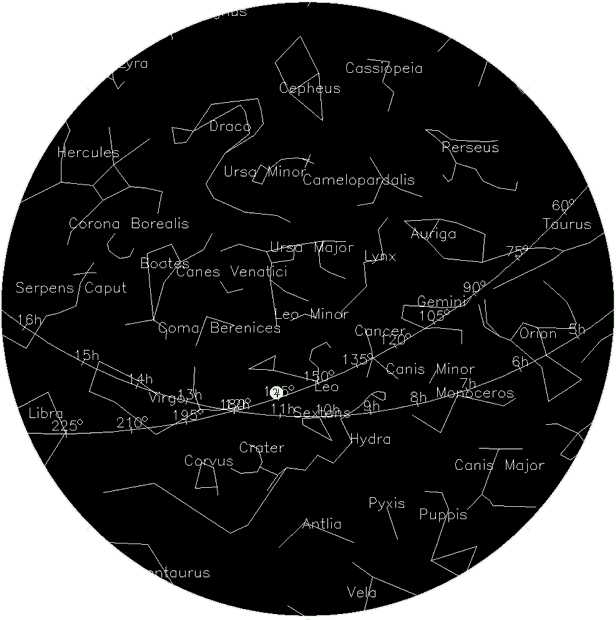SKY HAPPENINGS
Moab
UT (at City Hall)
38O34’ N Latitude 109O33’ W Longitude
4048 ft - 1234 m |
The Sky for April 2016
By Faylene
Roth
Sunrise-Sunset
for April
(The time of sunrise and sunset assumes a flat horizon. Actual time may vary depending upon the landscape.) |
DATE |
SUNRISE |
SUNSET |
1 |
7:02am |
7:42pm |
2 |
7:01am |
7:43pm |
3 |
6:59am |
7:44pm |
4 |
6:58am |
7:45pm |
5 |
6:56am |
7:46pm |
6 |
6:55am |
7:47pm |
7 |
6:53am |
7:48pm |
8 |
6:52am |
7:49pm |
9 |
6:50am |
7:50pm |
10 |
6:49am |
7:51pm |
11 |
6:47am |
7:52pm |
12 |
6:46am |
7:53pm |
13 |
6:44am |
7:54pm |
14 |
6:43am |
7:55pm |
15 |
6:41am |
7:55pm |
16 |
6:40am |
7:56pm |
17 |
6:39am |
7:57pm |
18 |
6:37am |
7:58pm |
19 |
6:36am |
7:59pm |
20 |
6:34am |
8:00pm |
21 |
6:33am |
8:01pm |
22 |
6:32am |
8:02pm |
23 |
6:30am |
8:03pm |
24 |
6:29am |
8:04pm |
25 |
6:28am |
8:05pm |
26 |
6:26am |
8:06pm |
27 |
6:25am |
8:07pm |
28 |
6:24am |
8:08pm |
29 |
6:23am |
8:09pm |
30 |
6:22am |
8:10pm |
|
Leo anchors the April night sky. Look for it directly overhead with Regulus—a 1st magnitude hot blue star—at the base of the backwards question mark that forms the lion’s head. Look eastward at about the same declination for Arcturus, a very bright but aging 0 magnitude orange-red star, in club-shaped Boötes. The “club” stretches northward with Arcturus at its base.
Ursa Major (Big Dipper) spreads out high overhead when facing north. The two stars at the outer edge of the dipper point northward to 2nd magnitude Polaris (North Star). The two stars at the handle edge of the dipper point southward to Regulus (Leo). Follow the arc of the handle southeastward to Arcturus (Boötes). Continue the arc southward to Spica (Virgo), another 1st magnitude hot blue star. The two stars that form the bottom of the dipper point eastward to 1st magnitude Capella (Auriga).
Twilight extends the period of daylight in three stages at each end of the day. Morning twilight begins with astronomical twilight—about 1-1/2 hours (nearly 2 during summer months) before sunrise—as the eastern horizon brightens. Nautical twilight continues—as the overhead sky turns blue and color returns to the surrounding landscape—for another 30-40 minutes. The final stage—civil twilight—provides adequate light for most outdoor activities for the half hour before the sun crests the horizon. The opposite progression occurs after sunset.
MOON HAPPENINGS
April 7 – Dark skies for several days before and after the new moon (5:24am).
April 14 – Dark evening skies. A waning last quarter moon rises after midnight.
April 21 – Full moon (11:24pm) rises at 7:43pm.
April 30 – Moonlit evening skies. A waxing first quarter moon sets after midnight.
(The moon rises later each day—as little as 30 minutes to as much as one hour. Time of moonrise and moonset may also be delayed in mountainous terrain.)
VISIBLE PLANETS
Morning (After Midnight)
Mars - red orb directly overhead before morning twilight at the top of the head of Scorpius. (brightening from -0.5 to -1.3 magnitude)
Saturn - golden disk about a fist’s width east of Mars. (+1.1 magnitude)
Evening (Before Midnight)
Jupiter - (brilliant white) high overhead in night sky on the ecliptic below Leo’s tail and about halfway between Regulus (Leo) and Spica (Virgo). (-2.2 magnitude)
Apparent magnitude values range from -4 to +6 for most planets and visible stars. The lower the value the brighter the object. A decrease of 1.0 magnitude is 2.5 times brighter.
Primary Sources: USGS; U.S. Naval Observatory; Your Sky at http://www.fourmilab.ch/yoursky/
To find out when the space shuttle and International Space Station are visible from your location,
go to: http://spaceflight.nasa.gov/realdata/sightings/index.html and click on Sighting Opportunities.
| MAJOR METEOR EVENTS |
Shower |
Peak
(April) |
Range
(April) |
Constellation Radiant |
Rate
(/hr) |
Details |
Conditions
(After Midnight) |
Lyrids
|
21-23 |
16-25 |
Hercules/Lyra |
10-15 |
Bright dust trails
|
Full Moon |
Fireballs |
14-30 |
14-30 |
Whole Sky |
- |
Large w/long-lasting trails |
Varies |
| Best time to view any meteor event is between midnight and morning twilight when the radiant is overhead. |
Trace the path of any meteor backwards through the sky to reach its radiant--the region of the sky from which meteors appear to originate. |
The star chart approximates the sky from astronomical twilight to midnight. As the night and month progresses, the constellations shift toward the northwest. The celestial equator is measured in hours (h).
The ecliptic is measured in degrees
Note: Hold your hand at arm’s length to measure apparent distances in the sky. The width of the little finger approximates 1.5̊. Middle, ring, and little finger touching represent about 5̊. The width of a fist is about 10̊. The fist with the thumb extended at a right angle equals 15̊. The hand stretched from thumb to little finger approximates 20̊-25̊. The diameter of both the full moon and the sun spans only 0.5̊. Adjust for the size of your hand.
|
